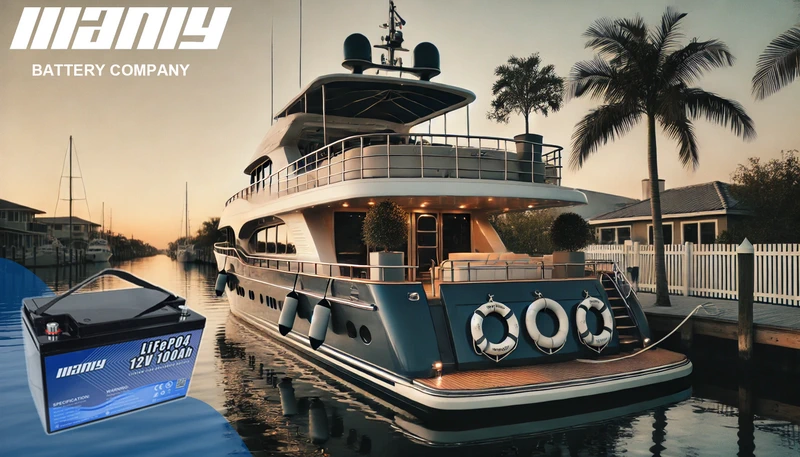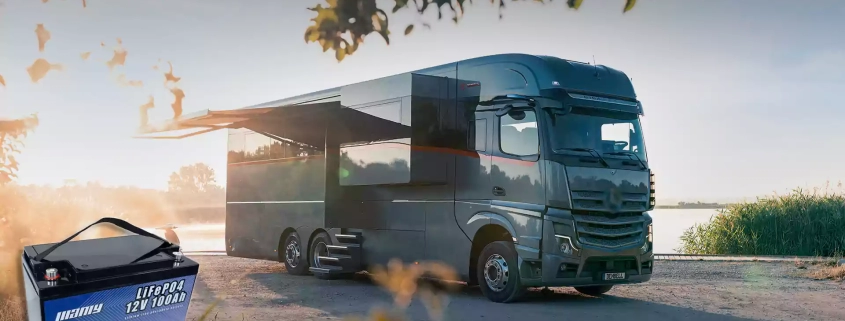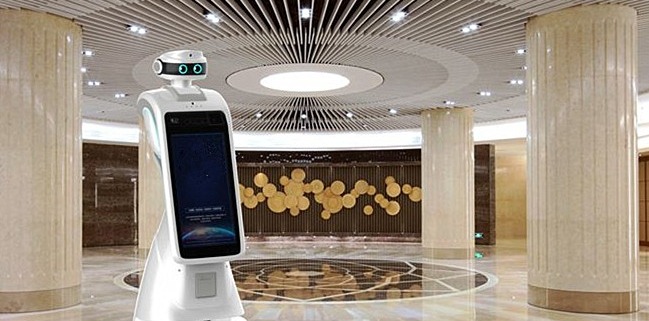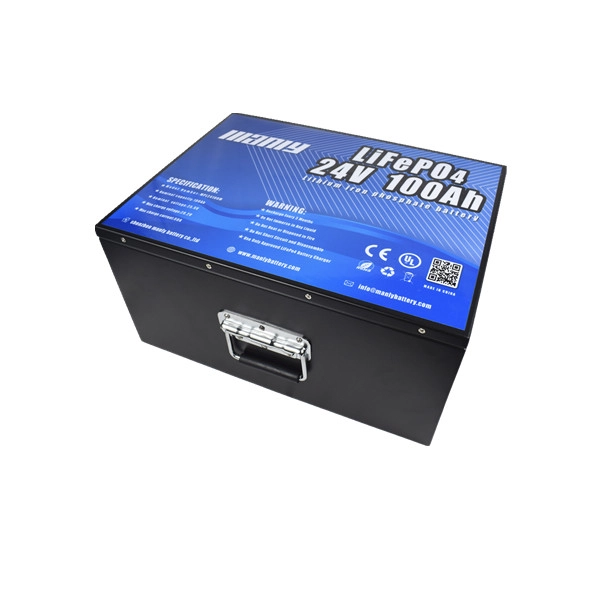What Type of Battery is a Marine Battery? A Detailed Breakdown
Table of Contents
- What Type of Battery is a Marine Battery? A Detailed Breakdown
- What is a Marine Battery?
- Different Types of Marine Batteries and Their Features
- The Best Choice: LiFePO4 Batteries for Marine Use
- Why LiFePO4 Batteries Are the Best Marine Batteries?
- Conclusion
- FAQ
- Hot Search
- The 6 Best Lithium Batteries for Motorhome
- The advantages of welcome robot
- Introduction and function of welcome robot
- Functions of Welcome Robot
- Different Types Of Welcome Robot
- The Power Drive: Top Batteries for Robotics
Maintaining a consistent and dependable boating experience depends on choosing the right marine battery. Whether you use a trolling motor, start your engine, or run electronics, the appropriate battery type will make all the difference. The several choices for batteries make many sailors find it difficult to choose the right one.
This article will break apart lead-acid, AGM, gel, and LiFePO4 batteries as well as other types of marine batteries. You will learn every type in great depth, including its benefits, drawbacks, and optimal uses. By the conclusion, you will understand the reason LiFePO4 batteries are the best fit for marine applications.
What is a Marine Battery?
Designed especially to withstand adverse sea conditions, a marine battery is Unlike automobile batteries, which only provide short bursts of electricity to start an engine, marine batteries must deliver constant power for lengthy durations while tolerating vibrations, dampness, and temperature variations.
- Usually driven by its intended use, marine batteries are categorized:
- The starting battery runs the boat motor. It gives a brief, sharp boost but lacks long-term vitality.
- Deep-cycle batteries run constantly for lights, fish finders, and trolling motors among other equipment.
- A dual-purpose battery sometimes performs worse than dedicated beginning and deep cycle batteries, even if it aims to combine two uses.
These classification indicate the use of a marine battery, although the most important factor influencing battery performance is battery chemistry. Chemistry of a battery determines its general performance, longevity, efficiency, and maintenance requirements.
Different Types of Marine Batteries and Their Features
The several kinds of marine batteries are listed below, together with their characteristics:
Lead-Acid Marine Batteries
Lead-acid batteries have been used in marine conditions as they have been rather competitively priced and widely available for decades. These batteries chemically react with lead plates and sulphuric acid to generate power.
Flooded Lead-Acid (FLA) Batteries
Flooded lead-acid batteries are the most classic form. They demand consistent maintenance, including topped off distilled water. They are heavy, require ventilation, have a shorter lifetime than other battery types even if they are economically priced.
Sealed Lead-Acid Batteries
Lead-acid batteries sealed eliminate maintenance needs and are spill-proof. Two most widely used variants that improve performance over typical flooded lead-acid batteries are AGM (absorbed glass mat) batteries and gel batteries.
Advantages of Lead-Acid Marine Batteries
Lead-acid batteries are reasonably cheap and rather numerous. Their great starting current makes them worth using for engine cranking.
Disadvantages of Lead-Acid Marine Batteries
Lead-acid batteries need regular maintenance, weigh a lot, and charge slowly. Usually running for two to four years, their lifetime is short; they break down upon discharge below 50% capacity.
AGM (Absorbed Glass Mat) Marine Batteries
AGM batteries are spill-proof and maintenance-free by absorbing the electrolyte using fiberglass mats, therefore improving traditional lead-acid designs.
How do AGM Batteries Work?
By immobilising the electrolyte inside the glass mat, AGM batteries reduce the possibility of leaking and hence maximise power efficiency. Since this structure lets for better resistance to vibrations and faster charging periods, AGM batteries are a more durable replacement for flooded lead-acid batteries.
Advantages of AGM Marine Batteries
Zero maintenance and faster charging than other lead-acid models describe AGM batteries. Their lifetime is between three and six years, and they have more resistance to deep discharges.
Disadvantages of AGM Marine Batteries
AGM batteries remain heavier than lithium alternatives even with their superior performance. On a tight budget, they also appeal less to boaters since they cost more than flooded lead-acid batteries.
Gel Marine Batteries
Gel batteries use liquid electrolytes from a silica-based gel. Less leaks and greater deep discharge performance are made possible by this chemical composition.
How do Gel Batteries Work?
The gel-based electrolyte lowers chemical reactions, therefore reducing the possibility of overcharging or deep discharge. Applications needing constant, long-term power will find ideal use for these batteries.
Advantages of Gel Marine Batteries
Gel batteries resist high temperatures, maintain a longer lifetime than flooded lead-acid batteries, and require no maintenance.
Disadvantages of Gel Marine Batteries
The slow charging rate of gel batteries is its biggest drawback. Furthermore expensive than AGM and flooded lead-acid batteries are they are. Less forgiving than other battery kinds, overcharging can damage a battery permanently.
The Best Choice: LiFePO4 Batteries for Marine Use
The most intelligent and powerful marine batteries are LiFePO4 (Lithium Iron Phosphate). Unlike lead-acid batteries, which rely on chemical interactions between lead and acid, they offer constant and dependable power by means of lithium-ion technology.
Why LiFePO4 Batteries are Superior?
Among their most important benefits are LiFePO4 batteries’ extended lifespan. Lead-acid batteries run two to six years; LiFePO4 batteries can run ten years or more. Since they weigh up to 70% less than lead-acid batteries and are more easily handled, they also greatly improve boat performance.
Charging time offers still another major advantage. Five times faster charging of LiFePO4 batteries than with lead-acid batteries Unlike lead-acid batteries, which have to be kept above 50% charge, they also enable total discharges free from battery damage.
Are There Any Drawbacks to LiFePO4 Batteries?
The sole negative of LiFePO4 batteries is their starting cost. For seasoned sailors, however, they are the most affordable choice because of their long lifetime, fast charge times, and low maintenance needs.
Why LiFePO4 Batteries Are the Best Marine Batteries?
LiFePO4 batteries have long-term benefits above all other battery models, even if their initial expense makes many sailors unwilling to switch. Boats carrying LiFePO4 batteries had 30% longer running lifetime on electronic systems and trolling motors, according a study by marine engineers.
Savings in weight also improve performance. LiFePO4 technology lets a boat greatly reduce the weight of its battery, therefore enhancing fuel economy and general maneuverability. Boaters looking for dependability, fast charging, and long-lasting performance would best invest in LiFePO4 batteries.
Conclusion
The perfect sailing voyage depends on selecting the right marine battery. Though lead-acid, AGM, and gel batteries are still somewhat popular, none give the efficiency, lifetime, and long-term savings LiFePO4 batteries offer.
LiFePO4 batteries from MANLY Battery provide the finest answer if you want a dependable and high-performance marine battery. Their innovative lithium technology guarantees exceptional energy economy, therefore assuring that your boat keeps running without the trouble of regular replacements.
For premium-quality marine batteries, visit MANLY Battery today and experience the next generation of marine power solutions.
FAQ
1. Is a deep cycle battery the same as a marine battery?
Let’s clarify: a deep cycle battery and a marine battery aren’t the same, although they have similarities. Here’s why:
A deep cycle battery provides a steady power flow over an extended period. It’s designed for applications that need consistent energy, like golf carts, RVs, or renewable energy systems. These batteries are built to handle repeated discharges and recharges without losing performance.
On the other hand, a marine battery is specifically made for boats. However, marine batteries come in two types: starting and deep cycle. A starting battery delivers a quick surge of power to start the engine, while a deep cycle marine battery powers your boat’s electronics and other devices.
So, while some marine batteries are deep cycle, not all deep cycle batteries work as marine batteries. If you’re choosing a battery for your boat, ensure it’s designed for marine use to get the most reliable power.
2. What are the three types of marine batteries?
Marine batteries come in three main types, each serving a different purpose. Understanding their roles helps you pick the right one for your boat:
- Starting Batteries: Starting batteries provide a quick burst of power to start your engine. They’re all about delivering a high-energy jolt for a short time. These batteries are not designed to power other devices, so they focus only on getting your engine running.
- Deep Cycle Batteries: Need power for your boat’s electronics, trolling motor, or other accessories? Deep cycle batteries are your answer. They deliver steady, long-lasting energy and can discharge and recharge multiple times without losing capacity. Perfect for extended trips or when you’re off the grid!
- Dual Purpose Batteries: As the name suggests, dual purpose batteries combine the functions of both starting and deep cycle batteries. They give you enough power to start your engine and supply energy to your accessories. They offer versatility but may not provide as much power as a dedicated starting or deep cycle battery.
Hot Search
Marine Lithium Battery Battery Manufacturer
Hello
Welcome robot has the following advantages:
1. It can stand by for 24 hours, and can not eat, drink, sleep, and have no human emotions. At most, it can be charged when the store is closed at night.
2. Robots can use big data to analyze, aggregate user information, and draw key information. Data reports can also be directly and systematically exported, which is much stronger than manual registration.
3. Improve the sense of technology and attract customers. Whether it is an adult or a child, passing by will always be more curious about intelligent robots.
4. More efficient and standardized operations, especially in government and enterprise service halls, hotels, museums and other places, after customers arrive, basic tasks can be completed independently, and the whole process service attitude is better.
5. During the epidemic, some companies’ robots can also perform body temperature detection, repeated broadcast of epidemic prevention publicity and other services.
6. To stand out among many competitors, user experience and exclusive experience are very important.
Manly focus on lithium battery with 13+ years experience, certified by IEC61960, IEC62133, UL2054, UL1642. We can custom lithium battery pack for you, which is safety and long service life.
The welcome robot is a high-tech exhibit that integrates speech recognition technology and intelligent motion technology. The robot is humanoid, and its height, body shape and expression are all striving to be lifelike, kind, cute, beautiful, generous, and lifelike. A sense of humanization.
Functions of Welcome Robot
Table of Contents
Autonomous welcome:
place the robot on the venues, hotels, shopping malls and other activities and promotion sites. When guests pass by, the robot will take the initiative to say hello: “Hello! Welcome.” When the guests leave, the robot will say: “Hello, welcome. next visit”.
Welcome speech:
The exhibition robot can deliver a “welcome speech” to the guests on the stage and on the spot. The “welcome speech” can be formulated by the user first, and then expressed through the robot’s unique voice effect after programming input.
Action display:
During the exhibition, the robot can perform talent shows such as singing, storytelling, and reciting poetry. The robot is also equipped with head, eye, mouth, and arm movements to fully demonstrate the entertainment function of the robot.
Human-machine dialogue:
The robot has the most advanced speech recognition function in today’s technology. On-site guests can use the microphone to ask many questions to the robot. The content of the dialogue can be formulated according to the user’s needs, and the robot answers the guests’ questions in humorous language. Through man-machine dialogue, the content of this event or celebration can be fully displayed to the on-site guests, and at the same time, the participation and entertainment of the guests can be increased, and a good interactive effect can be produced.
Different Types Of Welcome Robot
In the ever-evolving landscape of robotics, welcome robots have emerged as fascinating and practical solutions to enhance guest experiences and provide efficient customer service. Designed to greet and assist visitors, these robots combine cutting-edge technology, friendly personalities, and a wide range of capabilities. In this article, we will introduce you to various types of welcome robots, showcasing their unique features and applications.
Reception Robots
Reception robots specialize in front-desk and reception duties, making them indispensable in hotels, corporate offices, and other establishments. These robots are designed to welcome guests, manage check-in processes, and provide essential information about the facility. Reception robots often come equipped with touchscreens or voice interfaces, allowing visitors to access real-time updates on schedules, room availability, amenities, and local attractions. By automating the check-in process and handling routine inquiries, reception robots enhance efficiency and ensure a seamless arrival experience for guests.

Service Robots
Service robots are the epitome of efficiency and practicality when it comes to welcoming guests. These robots excel in tasks such as providing directions, answering frequently asked questions, and offering assistance with luggage or personal belongings. Equipped with advanced navigation systems, sensors, and mapping technology, service robots can autonomously navigate complex environments such as airports, shopping malls, and hotels. They ensure a smooth and hassle-free experience for visitors, saving time and reducing the workload of human staff.
Social Robots
Social robots are designed to create engaging and interactive experiences for visitors. These robots possess the ability to recognize and respond to human emotions, making them ideal companions for individuals in various settings. Social robots greet visitors with personalized messages, engage in conversations, and even showcase expressive gestures and facial expressions. With their natural language processing capabilities, they can hold meaningful dialogues, share information, and provide entertainment. Social robots are particularly effective in environments such as museums, exhibitions, and public spaces, where they offer a unique blend of companionship and amusement.

Multilingual Robots
Multilingual robots are specifically programmed to overcome language barriers and cater to a diverse range of visitors. These robots possess advanced language translation capabilities, enabling them to communicate with guests in their native language. By offering real-time translation services, multilingual robots facilitate effective communication, provide information, and create a welcoming environment for international visitors. They are particularly valuable in tourist destinations, international conferences, and global events.
Guiding Robots
Guiding robots excel in providing navigational support and information to visitors in large spaces like museums, exhibitions, and airports. Equipped with cameras, sensors, and mapping technologies, these robots can guide guests to specific locations, offer information about exhibits or points of interest, and even narrate historical or educational content. Guiding robots enhance the overall visitor experience by offering personalized and interactive tours, ensuring guests have a memorable and enriching time.
Hospitality Robots
Hospitality robots are designed to enhance the overall experience of guests staying in hotels or resorts. These robots can perform a variety of tasks, such as delivering amenities, providing weather updates, managing room controls, and even entertaining guests with games or multimedia content. With their ability to interact and adapt to individual preferences, hospitality robots create a unique and personalized experience, ensuring guests feel valued and cared for throughout their stay.
Informational Robots
Informational robots act as knowledgeable assistants in public spaces, helping visitors with inquiries and providing relevant information. Equipped with vast databases, these robots can answer questions about nearby attractions, transportation schedules, restaurant recommendations, and other local information. By offering accurate and up-to-date information, informational robots become invaluable resources, empowering guests to explore new places confidently.
The Power Drive: Top Batteries for Robotics
Robotics is a fast-growing field that requires highly efficient power sources. As the heart of any robot, the battery greatly influences a robot’s performance, lifespan, and capabilities. Therefore, choosing the right robot battery is critical. This article aims to guide you through the complex world of batteries for robotics, highlighting top manufacturers, including MANLY Battery.
The Lifeline of Robotics – The Battery
Robots are no longer just characters in science fiction movies. They have invaded every sector, from manufacturing and healthcare to education and home automation. Powering these machines are batteries, the lifeline that sustains their operations.
The main factors to consider while selecting robot batteries include:
- Capacity: Measured in ampere-hours (Ah), it denotes how much power a battery can store.
- Discharge Rate: It shows how quickly a battery can deliver power.
- Lifecycle: It indicates the number of charge and discharge cycles a battery can go through before its capacity falls below 80%.
- Price: The cost of the battery is essential, especially for those looking for cheap LiFePO4 batteries.
Types of Robot Batteries
There are several types of batteries used in robotics, with each type having its unique characteristics. They include:
- Lithium-ion (Li-ion) Batteries: These batteries offer high energy density and long lifecycle but can be expensive.
- Lithium Iron Phosphate (LiFePO4) Batteries: These are cheaper than Li-ion batteries, have a longer lifespan, and are safer due to their thermal and chemical stability.
- Nickel-Metal Hydride (NiMH) Batteries: While cheaper, these batteries have a lower capacity and shorter lifecycle than lithium batteries.
- Lead-Acid Batteries: These are the cheapest but have the lowest energy density and the shortest lifecycle.
Leading Producers of Batteries
In the vast world of battery technology, there are some manufacturers that truly stand out due to their innovation, quality, and reliability. Here’s a look at some of the top battery producers:
- Duracell: As a household name, Duracell offers a vast selection of battery types, known for their longevity and reliability. From standard alkaline batteries to rechargeable solutions, Duracell products are trusted worldwide.
- Energizer: Another recognizable name in the market, Energizer provides a wide array of battery types. Notable for their high-energy output and long-lasting performance, Energizer batteries are commonly used in various applications, including robotics.
- Samsung SDI: A prominent player in lithium-ion technology, Samsung SDI provides high-quality, energy-efficient batteries. They are also making significant strides in the renewable energy sector with their innovative solutions.

- LG Chem: Focused on providing advanced energy solutions, LG Chem offers high-capacity lithium-ion batteries known for their efficiency and durability. They also contribute significantly to electric vehicle (EV) technology with their state-of-the-art EV batteries.
- MANLY Battery: Over a decade of industry experience, is renowned for its customized, high-quality solutions. Their products come with an impressive 10-year warranty, standing as testament to their commitment to quality and longevity. The company prides itself on rigorous factory inspections before shipping. Moreover, Manly Battery’s product line boasts remarkable features such as overvoltage and overcurrent protection, as well as resilience to significant impacts. Their Lifepo4 batteries are specially designed for easy integration, serving as a drop-in replacement for lead-acid batteries.
Selecting the right battery is vital for the efficient functioning of a robot. Factors such as capacity, discharge rate, lifecycle, and cost should guide your decision. Among the top manufacturers, MANLY Battery offers a competitive edge with its high-capacity, reliable, and affordable LiFePO4 batteries. However, the choice ultimately boils down to the specific requirements of your robotic application.








